Ninety years of the St Albans Symphony Orchestra
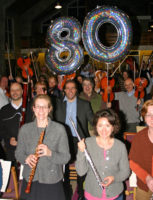 Ninety years ago, when Edward Elgar and Gustav Holst were still alive and Benjamin Britten was a music student, five young, amateur musicians travelling back from a concert in London decided that St Albans needed its own symphony orchestra. They had recently played for St Albans Operatic Society and decided to recruit its conductor, Augustus F. Lowe, “to take a few rehearsals and see how things would shape.” Just twelve musicians were present at the first rehearsal in June 1931, but by the autumn, as many as 40 were attending. As a result, the St Albans Orchestral Society gave its first concert in the Victoria Hall on Tuesday 19th April 1932. The programme (price threepence) describes an extended evening. It began with Beethoven’s Egmont Overture and six further items, including Schubert’s Unfinished Symphony, Mendelssohn’s Second Piano Concerto (with Lowe as soloist) and the New World Symphony by Dvorak. The archives also record that The Marchioness of Salisbury, daughter-in-law of the late Prime Minister, had agreed to become the orchestra’s first President. The early concerts were well received. The St Albans Times speculated after a performance of Tchaikovsky’s Nutcracker Suite that the orchestra “must have devoted many months of practice to capture the essentials of so fascinating and brilliant a work.”
Ninety years ago, when Edward Elgar and Gustav Holst were still alive and Benjamin Britten was a music student, five young, amateur musicians travelling back from a concert in London decided that St Albans needed its own symphony orchestra. They had recently played for St Albans Operatic Society and decided to recruit its conductor, Augustus F. Lowe, “to take a few rehearsals and see how things would shape.” Just twelve musicians were present at the first rehearsal in June 1931, but by the autumn, as many as 40 were attending. As a result, the St Albans Orchestral Society gave its first concert in the Victoria Hall on Tuesday 19th April 1932. The programme (price threepence) describes an extended evening. It began with Beethoven’s Egmont Overture and six further items, including Schubert’s Unfinished Symphony, Mendelssohn’s Second Piano Concerto (with Lowe as soloist) and the New World Symphony by Dvorak. The archives also record that The Marchioness of Salisbury, daughter-in-law of the late Prime Minister, had agreed to become the orchestra’s first President. The early concerts were well received. The St Albans Times speculated after a performance of Tchaikovsky’s Nutcracker Suite that the orchestra “must have devoted many months of practice to capture the essentials of so fascinating and brilliant a work.”
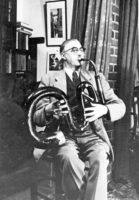
Lowe continued to conduct annual November concerts until 1939, although illness meant the St Albans Abbey organist, Dr Albert Tysoe, took the 1938 concert. Soloists included the renowned violinist Albert Sammons. Rehearsals continued through the Second World War, taking place on Saturday afternoons to avoid the blackout. There were no further performances until 1943 when bassoonist Lewis Covey-Crump, one of the orchestra’s founder members, conducted a fund-raising concert in aid of the Red Cross.
Concerts “of full proportions” resumed in 1946 under the baton of Robert Lindsay, a viola player who had taught himself to conduct while teaching at St Albans School during the war. By then teaching at St George’s School, Harpenden, he remained the orchestra’s conductor for the next thirty years. During his tenure, the repertoire came to include more contemporary composers. The Festival of Britain in 1951 was celebrated with a programme of works by Vaughan Williams, Stanford, Elgar and Warlock. Advertising for this concert warned that: “The capacity of the Conservative Hall is somewhat limited and early booking of seats is advisable.”
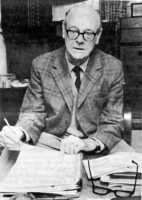
In 1953 the venue for rehearsals and many concerts switched to the hall of St Albans Girls’ Grammar School. Six founder members played when the orchestra celebrated its Silver Jubilee in 1957, including Lewis Covey-Crump and his wife Joyce (violin) who had participated in the original meeting on a train. The podium for the first half was shared by Covey-Crump and Robert Lindsay, with Augustus Lowe appearing as the soloist in Beethoven’s First Piano Concerto. The second half was a performance of the Franck D minor Symphony under the baton of the Society’s President, Prof Aylmer Buesst, a St Albans resident who had formerly conducted the British National Opera (and recorded with the tenors, Caruso and Heddle Nash). His pianist daughter Jill subsequently appeared with the orchestra playing Schumann’s Concerto in A minor in 1958 when her father conducted, and again in 1971.
During the Lindsay years, the orchestra became a founder member of the St Albans St Cecilia Festival Society, whose biennial choral concerts started in 1955 with Handel’s Messiah under Dr Reginald Jacques. Two years later, Meredith Davies, a former Director of Music at the Abbey (whom Britten later chose to conduct the premiere of his War Requiem) was in charge. Giving only two concerts a year of its own, the orchestra attracted a number of distinguished soloists. These included violinists Erich Gruenberg and Iona Brown, the cellist Alexander Baillie and pianist Alan Schiller. From 1972, performances took place in the City Hall, now the Alban Arena.
Robert Lindsay retired as conductor in 1976, returning to the viola section he had left 30 years earlier. Joyce Covey-Crump, the only founder member still playing, chose the same moment to retire. Erich Gruenberg, appearing 26 years after his first performance with the orchestra, played the Brahms Violin Concerto, while Lindsay’s American successor, William Jackson, conducted Brigg Fair by Delius. Jackson, a professional cellist and pianist from California, had studied conducting with Pierre Monteux and was hoping to build a career in Europe. He returned to America two years later, but is credited with expanding the orchestra’s membership and the number of concerts. One memorable concert included the Mozart G major Concerto (K453) played by Fou Ts’ong. Sadly, it also became necessary in 1978 to mark Robert Lindsay’s death, with a performance of Eight Russian Folksongs by Liadov. This was remembered as one of the late conductor’s favourite pieces, and one of many works whose parts he had transcribed for the orchestra by hand.
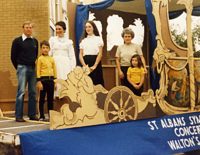
Geoffrey Barker, the orchestra’s leader and a music teacher at Aldenham School, succeeded Jackson. With an expanded brass section he was able to embrace a wider repertoire, including Mahler’s First Symphony. The orchestra learned, with sadness, of Geoffrey’s death in January 2012. Pianist John Lill was among the soloists during SASO’s 50th season, while a Golden Jubilee concert included Tchaikovsky’s First Piano Concerto, with Harvey Dagul, and Bach’s Orchestral Suite No 3, featuring violinist Jennifer Wigram. The former had recently become the orchestra’s President, remaining in post for the next 30 years. Jennifer, who retired from leading the orchestra in July 2019, marked her 30th anniversary by performing The Lark Ascending by Vaughan Williams at the 2012 New Year Concert.
Cementing that sense of stability, Andrew Parnell, the Assistant Master of Music at the Abbey and Director of Music at St Albans School took over the baton in 1983 and remained conductor for the next 18 years. Lasting innovations included popular New Year Family Concerts held in the Abbey from 1984 and, more recently, annual children’s concerts. The latter are subtitled Noisy Kids in apt recognition of the opportunities for children to ‘try the instruments’ during the interval. Collections at New Year for local and international charities, meanwhile, maintained and extended the orchestra’s long tradition of fund-raising events.
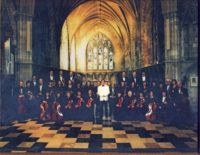
Highlights of the Parnell era included so large an assembly of St Cecilia forces to perform the War Requiem in 1988 that the three choirs and Cathedral choristers were obliged to stand while the work was performed without interval. One woodwind principal subsequently admitted to being so moved by the intensity of the conclusion that he entirely missed his final entry. The orchestra’s 60th anniversary in the Alban Arena was marked by the return of John Lill to play Beethoven’s Emperor Concerto and the first performance of Canzona, commissioned from the composer Leonard Salzedo. Beethoven’s Ninth Symphony commemorated the 50th anniversary of the United Nations in 1995, with Colin Bradbury as soloist in Mozart’s Clarinet Concerto. More extraordinary was an arrangement of a Handel Harp Concerto performed at New Year by local teacher Margaret Knight and sixteen of her pupils. Likewise, the memorable appearance of the clarinet prodigy Julian Bliss, in 1999 when aged only nine. While the young soloist performed a concerto by Crussell with distinction, it is recalled that his reeds were prepared for him by his mother.
Other internationally celebrated soloists who performed with SASO included the pianists Malcolm Binns and Peter Katin, trumpeter Rod Franks and the oboist Nicholas Daniel. The first children’s concert featured Harvey Dagul and his wife, Isabel Beyer as duettists in Carnival of the Animals by Saint Saens. Their son, Guy Dagul, also appeared with the orchestra, playing Gershwin’s Rhapsody in Blue and Shostakovich’s Concerto No 2 in another remarkable concert when his mother played Franck’s Symphonic Variations.
It was testimony to the orchestra’s growing reputation that when Andrew Parnell resigned in 2001, there were more than 60 applicants to succeed him. Following shortlisting and auditions James Ross, a finalist in the 1998 BBC Philharmonic Orchestra Conducting Competition, was the unanimous choice. Growing membership, including a full brass section, and ambitious programming, resulted in performances of major works by Bruckner, Mahler, Janacek and Stravinsky as well as Walton’s Belshazzar’s Feast, Elgar’s Dream of Gerontius and Tippett’s Child of our Time (St Cecilia Society).
Thanks to grant support provided by the Arts Council, the Eastern Orchestral Board and St Albans City Council the orchestra was also able to form a working partnership with the City of London Sinfonia. This not only allowed the various sections of the orchestra to receive professional coaching but also funded two ‘Composers Days’ when a selection of scores submitted by contemporary composers were rehearsed and performed. Expert guidance at these workshops, held in 2006 and 2007, was provided by the distinguished composers Roxanna Panufnik and Paul Patterson.
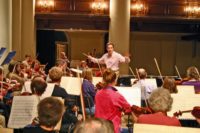
Other highlights during James Ross’s tenure included a 2002 performance of Brahms Second Piano Concerto with Harvey Dagul, celebrating his 70th birthday, and performances of Elgar’s Concerto and Tchaikovsky’s Rococo Variations with Guy Johnston, the Harpenden cellist who came to national prominence as BBC Young Musician of the Year in 2000. International horn virtuoso Stephen Stirling played the Horn Concerto No 2 by Richard Strauss. The orchestra was also invited to play for special events, including a charity performance in 2004 with Dame Diana Rigg as narrator in Prokofiev’s Peter and the Wolf. SASO gave its first performances in London at St John’s Smith Square in 2003 and 2005, raising money for the Fund for Epilepsy. When the orchestra celebrated its 75th birthday (memorably performing Stravinsky’s Rite of Spring) the concert programme noted how the concerts in London had provided: “…a pleasing counterpoint to the founders’ railway journey of 75 years ago”. Three years later, James Ross left to concentrate on a growing international career, concluding his nine-year association with Mahler’s ‘Resurrection’ Symphony.
Bjorn Bantock, his successor, was appointed from September 2010. A great-grandson of the composer, Sir Granville Bantock, he grew up in South Africa and came to Britain on a scholarship to study ‘cello at the Royal Northern College of Music. Under his baton the orchestra continued to raise its playing standards while tackling demanding repertoire. The highlights included Strauss’s epic Alpine Symphony and a cycle of Beethoven Symphonies (from Fifth to Ninth) culminating in an acclaimed performance of the ‘Choral’ Symphony with the Hertfordshire Chorus in March 2015. In addition, the orchestra played for a strikingly successful concert performance of Wagner’s opera Die Meistersinger von Nurnberg conducted by Mike Thorne in 2014 at the newly-opened Saffron Hall in Saffron Walden.
In 2016, after Bjorn Bantock moved to Bedford, the orchestra appointed Tom Hammond as Principal Conductor, following a rigorous selection process. Selected by Sir Charles Mackerras as the first Junior Fellow in conducting at Trinity Laban Conservatoire (2006-08), his work with other orchestras, professional and amateur, had already won him critical acclaim. Under his baton, SASO went from strength to strength with a succession of highly-praised concert seasons. Soloists included the violinists Clare Howick and David le Page, ‘Cellist Matthew Sharp and the horn player, Pip Eastop. The St Albans-based pianist (composer and conductor) Alissa Firsova also made a number of memorable appearances, performing concertos by Beethoven, Rachmaninov, Brahms and Tchaikovsky.
On March 7th 2020, the orchestra performed an ambitious programme that included Elgar’s Cello Concerto (with Matthew Sharp) and Walton’s First Symphony. Within days, the whole country was plunged into ‘lockdown’ in response to the spreading Covid-19 virus and the orchestra was unable to play in public again until October of the following year when a partial easing of restrictions made concerts possible. Tom Hammond conducted Tchaikovsky’s Fourth Symphony and Shostakovich’s Second Piano Concerto with Veronika Shoot as soloist. Tragically, this was Tom’s last concert with the orchestra as just after Christmas he died from a cardiac arrest, aged just 47.
The stunned immediate response to his sudden death was cancellation of the 2022 New Year Concert. However, the orchestra was subsequently able to share its sense of loss and lasting affection for Tom by performing programmes that he, himself, planned. These included a roof-raising account of the Saint-Saens Third Symphony in the Cathedral, with SASO’s former conductor Andrew Parnell at the organ, and a bitter-sweet performance in St Saviour’s of Malcolm Arnold’s Fifth Symphony – work in which the composer mourns the untimely deaths of his own musician friends. The orchestra was fortunate that Bill Carslake, a popular guest conductor on several previous occasions, kindly agreed to take over the remainder of the 2021-22 season.
In October 2022, the Orchestra marked its 90th anniversary with the world premiere of Heartwood Wilding, a symphonic poem specially commissioned from the composer, James Francis Brown. The work, which celebrates the physical and spiritual growth of the new forest that has been created since 2009 near St Albans, is dedicated to Tom Hammond’s memory. The first performance, conducted by the composer as part of the St Cecilia Festival concert, was enthusiastically received by a large audience in the Cathedral.
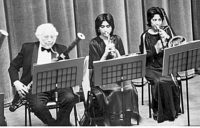
In ninety years numerous members and friends of the orchestra contributed to its organisation and activities. Special mention should be made of the oboist and bassoonist, the late Dr Roland Booth who, with his wife Nancy, played a major part in the orchestra’s development for more than half a century. Likewise, Tony Wigram, Jennifer’s husband, whose death from brain cancer occurred on the eve of the 2011 Festival Concert. An internationally renowned music therapist, Tony played with, and led, the orchestra’s viola section for many years. We also remember Babs Yule, a long-time Friend of SASO whose generous bequest to the orchestra following her death in 2010 was used to fund a commemorative series of workshop weekends featuring such difficult repertoire as Shostakovich’s ‘Leningrad’ Symphony and the Lutoslawski Concerto for Orchestra. In September 2014, the orchestra mourned Kieran McGuirk who, as chairman for the previous seven years had made an important administrative contribution to SASO’s development.
At a time of severe economic uncertainty, even long-established community orchestras can no longer expect public grants to subsidise their activities. Yet St Albans Symphony Orchestra continues to flourish, giving six or more concerts each season. Its main performing venues are St Saviour’s Church and – reflecting the growing popularity of its concerts – St Albans Cathedral. Thanks in no small part to its loyal and expanding audiences, SASO at the mature age of 90 finds itself in robust musical health.
David Utting
